AFFILIATE MARKETING
5 Steps & Expert Tips Included

Want to know how to find low-competition keywords that rank?
No problem.
In this post, you’ll discover 5 simple steps you can take to make the process a breeze.
You’ll also learn:
- How to do keyword research
- Which tools to use
- How to validate competitiveness
- And much more.
Let’s get started.
How to Find Low Competition Keywords – Step by Step
In this section, we’ll look at the steps involved in doing research for low-competition keywords. Then, after the steps, we’ll look at different tools available and how to use them.
By the end of this section, you’ll be able to approach keyword research with confidence and find keywords you know you can rank for.
Step 1: Find Seed Keywords
Before you can find low-competition keywords, you need a starting point. And that starts with seed keywords.
Seed keywords are broad keyword topics related to your niche, and they help you brainstorm ideas.
They tend to be one or two words, are highly competitive, and have high search volumes.
Think of a seed keyword as a large net when fishing. You cast your seed keyword net out into the web and find hyper-relevant, low-competition keywords.
I’ll show you different ways you can do this later.
But here’s a quick example.
Let’s say your blog is in the tech niche. A seed keyword could be any of the following:
- Digital cameras
- Laptops
- PC Monitors
- Drones
- And so on…
You’ll then use a keyword research tool or Google to narrow down your list into more specific keywords. Such as:
- Best lens for sony cameras
- Best laptops with HD webcam
- How to clean a pc monitor
- Best type of drone for photography.
To find seed keywords, you can use Google, Amazon, Reddit, or Quora to give you some ideas.
Now you can move on to the next step, which is to gather your list of keyword ideas and add them to a spreadsheet.
Step 2: Gather Your Keywords
When performing keyword research for low competitive keywords, it’s a good idea to store them somewhere to keep things organized.
Google Sheets will work fine, or you can use Excel or AirTable.
Create columns for the keywords, one for search volumes and another for keyword difficulty.
When you find new keywords, add them to your sheet.
Many of the keywords you find will have low search volume, but this shouldn’t put you off.
These keywords, also known as long-tail keywords, can be really powerful with the right blog content strategy.
Plus there are way more searches performed on Google that are low competition than there are high competition keywords.
This is where the name long-tail comes from because these keywords show up at the end of the search demand curve.

This means that smaller sites that target lots of low-competition keywords still have a lot of potential.
Once you’ve completed all the steps below, you’ll have a list of low-competition keywords you can target on your blog.
Step 3: Validate Keyword Intent
This step is really important because without validating the keyword intent, you might never rank for the keyword.
To clarify, keyword intent (or search intent) is the context behind a search. That means the keyword needs to match the type of content the searcher is looking for.
For example, someone searching for cheap blenders isn’t looking for recommendations. They just want to see cheap blenders and make a purchase.
Whereas the search best cheap blenders has the intent of finding recommendations before they make a decision.
The best way to know what the search intent is is to do a search for the term and see what the results show.
Then, you can add this detail to your spreadsheet.
Step 4: Know Your Content Types
Knowing the different types of blog content will help you target your audience more effectively.
Additionally, knowing how these content types relate to the keywords you find makes the blogging process much easier.
The first content type is informational posts which educate the reader and provide value.
These posts relate to keywords that start with how, why, what, and so on. They might also contain the words guide, tutorial, and tips.
When you find keywords like these, you know they are informational and tend to attract people at the top or middle of the funnel.
The top of the funnel is where people aren’t fully aware of a problem yet, and need to do more research before being ready to buy something.
And the middle of the funnel is where people are in research mode. They know of a specific problem and they are trying to solve it by searching these keywords.
A second content type is commercial content. These are posts that help the reader make a buying decision.
They relate to keywords that contain the words best, review, and vs. They also attract people at the bottom of the funnel, which are people ready to buy.
When you’re gathering your list of keywords, you’ll notice that informational keywords tend to be less competitive than commercial ones.
That’s because more websites are going after commercial keywords, as they will bring in more commissions.
With that said, there are still tons of low competition keywords with commercial intent. However, it’s good practice to find a combination of both types of content for an effective strategy.
Step 5: Validate Keyword Competitiveness
The last step is often the most appealing for many people. And that is to validate whether the keywords you find are low competition.
This can be done in a few ways, but the easiest way is to use a tool with keyword difficulty.
Depending on the keyword research tool, keyword difficulty is measured in different ways.
Factors that are considered by these tools include:
- Keywords in the SEO title and description
- Domain and page authority
- Backlinks.
The difficulty score is usually between 0-100, with low competition keywords below 30.
Thus, providing you with the green light to target the keyword on your site.
Of course, it’s still important to do further analysis of the top-ranking pages so you know what you’re up against.
It’s also important to make sure you can create content for the keyword that matches the search intent, as discussed above.
Now you know all the steps involved, below are some tips and tools you can use to make the process a breeze.
Expert Tips to Help You Find Low Competition Keywords
In this section, we’ll look at some specific techniques you can perform to find low-competition keywords.
Brainstorm Topic Ideas for Seed Keywords
Before you start, it’s best to find some seed keywords that you can expand on. This can be fairly straightforward, depending on the niche and your knowledge of it.
For starters, searching Quora for your main keyword can help you find more seed keywords you hadn’t thought of:

Doing the same thing on Reddit brings up some interesting conversations. And more seed keyword Ideas:

Another place you can find seed keywords is Amazon. Search Google for amazon bestsellers “your niche” to find products in your niche.
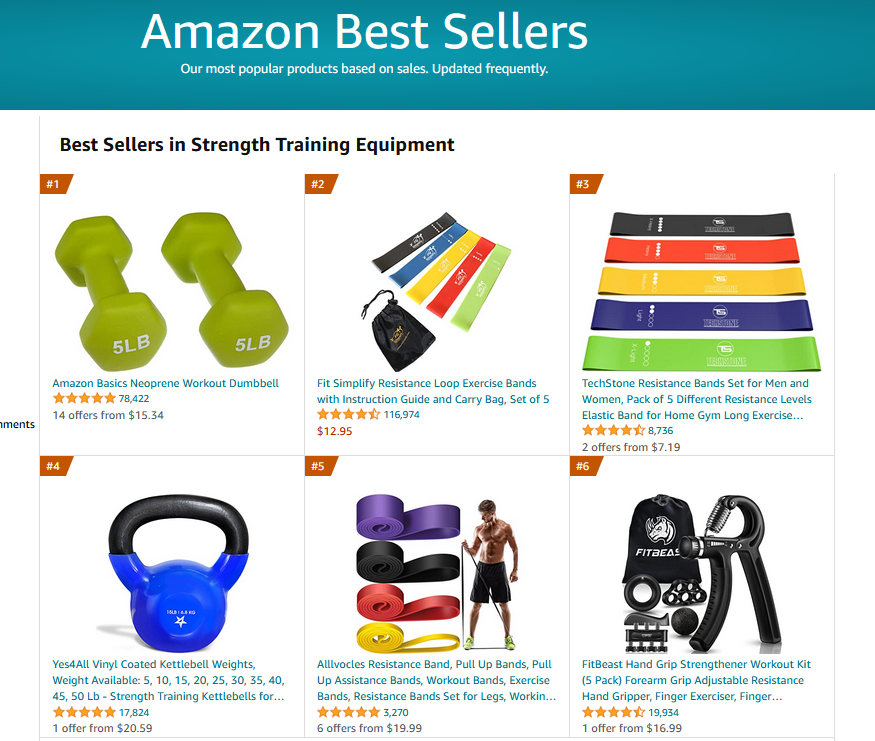
From your category, you’ll see a list of the top 100 products. Any one of these products could be used as a seed keyword to could give you more ideas.
Lastly, Pinterest is another great place to find seed keywords. This can help you think of ideas a little more outside the box.
It’ll also give you ideas of the types of content other people in your niche are creating.
This search for “macrame” led me to this Pin, which led me to a huge list of macrame terms I could use as seed keywords.

To keep all your ideas organized and to expand on them, you could create a mindmap like this one:

This was made with a free mind mapping tool called Coggle.it. Place your niche in the center and let ideas come to you.
Use Keyword Research Tools that Measure Keyword Difficulty
The fastest way to find low-competition keywords is to use a keyword research tool with a keyword difficulty score.
This makes it so much easier to validate whether you’ll be able to rank for the terms on your site.
The first tool we’ll look at is SEMRush. This tool categorizes the keyword types into columns. Keyword variations and questions:
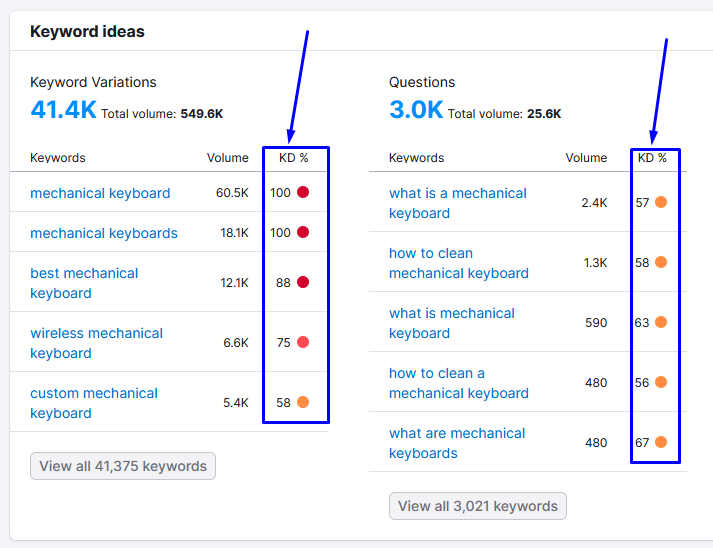
We can see that the question-related keywords have a lower KD score. If you click on this list, you can filter the available keywords by keyword difficulty:

All these keywords it returned have a KD score of less than 30, which is considered by SEMRush, easy to rank for.
You can get a 7-day free trial with SEMRush and apply even more filters such as search volume. This will help you find low competition keywords with high search volume.
Searching for the same seed keyword mechanical keyboard in SerpStat returns a variety of results.

You can also filter the list to include keywords that contain specific words. Words such as how, what, can, and why will return question-related keywords:

SerpStat is another paid tool and offers a free 7-day trial.
The last tool we’ll look at is SEMScoop. With this tool, you can take a list of keywords you find and import them into the software:

It’ll then display these in the list and show you the keyword difficulty when you click on them.

It’s a great way to get keyword difficulty scores for free.
Reverse Engineer the Competition
Using any of the tools mentioned above, this method enables you to find low-competition keywords fast.
But before you can use this method, you need to find one of your competitors.
To find competitors in your niche, search Google for best [your niche] blogs.
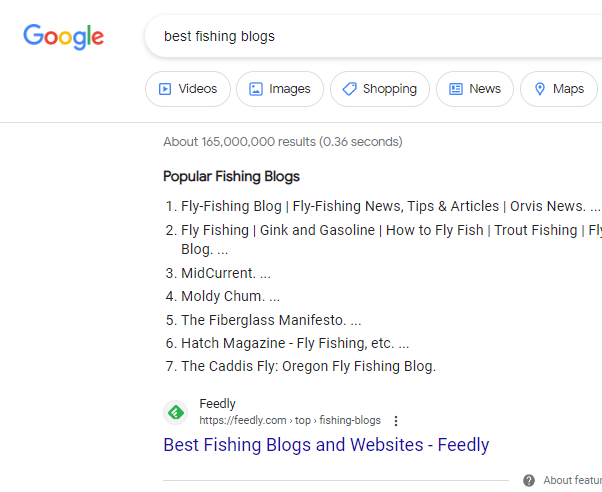
You’ll find articles that list the best blogs in your niche, which you can use to reverse engineer.
When you have a few competitors, search for them in the keyword tool of choice. I’m using Serpstat but of course, Semrush does this as well.
You’ll see a list of keywords this is already ranking for:

To narrow down the search, use the filters:
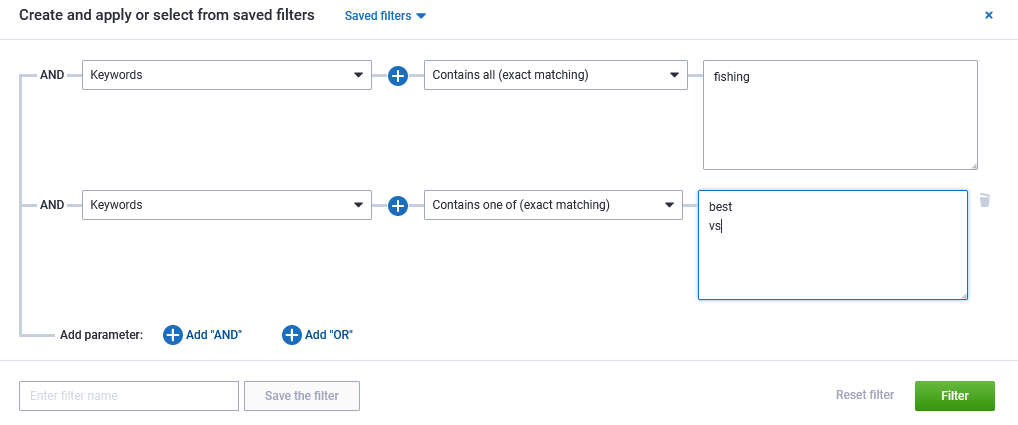
This example is for the fishing niche, so I’ve filtered for the word fishing, along with any occurrences of “best” or “vs”.
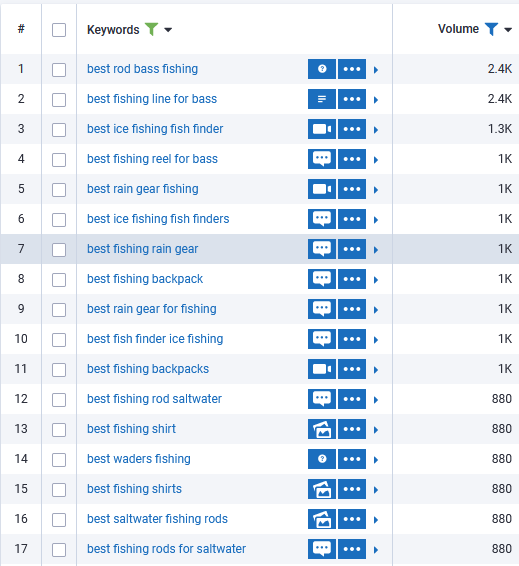
The results I found to have quite high search volumes, so they might be too competitive.
I can find easier keywords to target by filtering for lower search volumes.
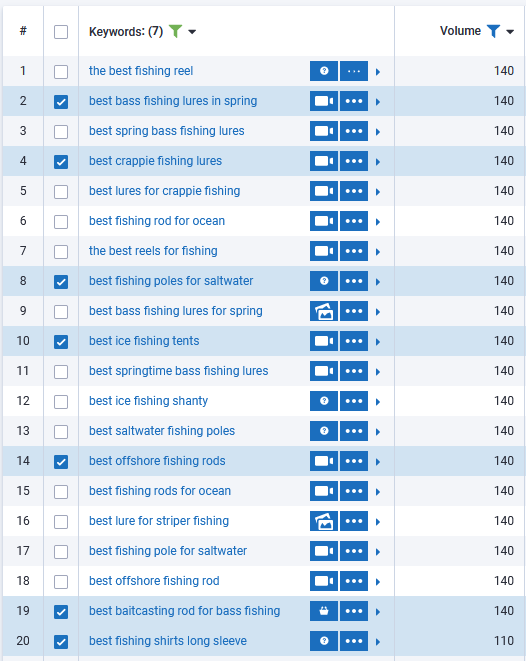
That’s better. Now I can use SEMScoop or another tool to check the keyword difficulty.
Sometimes it’s possible to find keywords with high search volume and a low KW score. Keep using the tools and persevere, and you’ll eventually find some.
Measure Keyword Competitiveness with a Free Tool
What if you don’t have a budget to spend on keyword tools? Is it still possible to find and validate if a keyword is easy to rank?
It sure is. Here’s how:
For this method, you’ll need to use Google Chrome and download the Chrome extension Mozbar:

Then start searching for your seed keywords or any variations you think could be low competition.
In my example, I’m searching for the best standing desks for gaming. Another tip is to add “affiliate disclosure” in quotations, like this:

Then what you want to look at are the PA and DA scores, which stand for Page Authority and Domain Authority.

The lower these scores are, the better chance you’ll have at ranking for them.
This site is in position 1 and has a Page Authority of 21 and a Domain of 28. As long as these scores are below 30, it should indicate low competition.
You can also add any sites you find to your list of competitors and use them to reverse engineer more keywords.
Just remember not to rely entirely on low-competition keywords. You need a decent amount of topically relevant content with good on-page SEO to get the best results.
Find Low Competition Keywords Using Google Search Console
This is a clever way to find low-competition keywords because your website is probably already ranking for them.
Head over to Google Search Console and click on Performance screen:

Then, go to your pages and look for one of your top-performing keywords based on either clicks or impressions:
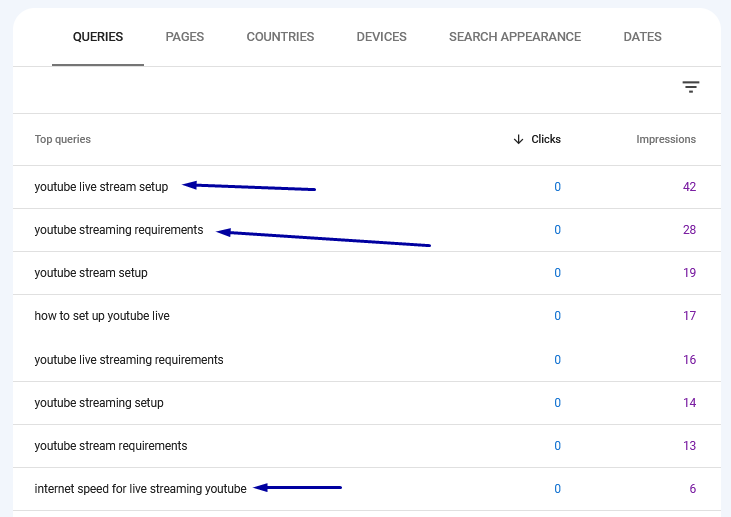
Click back over to Queries, and you’ll see a list of all the keywords that the post ranks for.
What you want to look for are keywords that are different from the main keyword of this page.
For example, the post on how to setup a youtube live stream on my tech blog also ranks for 3 other keywords I could target.

You could then use one of the tools mentioned in this post to find the search volumes.
However, it’s still a good practice to publish this content, as it will boost the SEO for the rest of your blog.
Just make sure you link each of the posts together for the best results. Our WordPress plugin Link Whisper can help with that.
Get Keyword Search Volumes (On a Budget)
If you want to know the search volume for keywords, but don’t have the budget for keyword tools, you’ll love this method.
This is also a great method if you’re not interested in keyword difficulty scores.
Sometimes the best way to validate a keyword is to publish content for it and see for yourself.
The first tool is Keywords Everywhere. This powerful tool turns your web browser into a keyword goldmine.
All you have to do is buy some credits (which are super cheap) and install the browser extension.
It works by displaying the search volumes of keywords that show up on any website you visit.
Here’s what it looks like in Google:
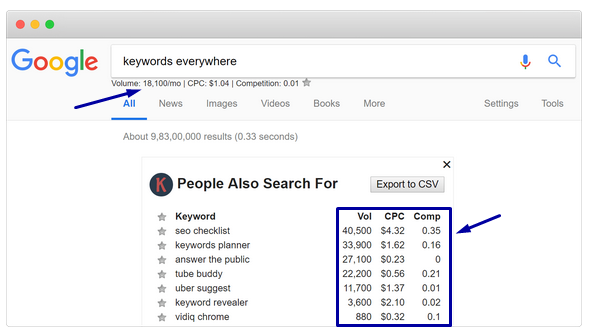
Pricing starts at $10 and that gives you 100,000 credits. Each keyword costs 1 credit and you can control exactly how many keywords show up.
You can read our Keywords Everywhere review to learn more.
Another tool for finding low competition keywords and their search volumes is Keyword Chef.
This keyword tool is great for finding long-tail keywords that are easier to rank for.
Here’s a search I did recently for mics for podcasting:
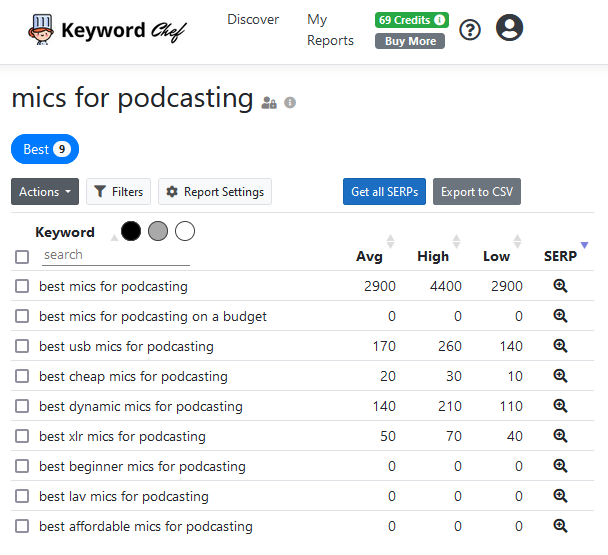
Keyword Chef offers a free trial, so you can test it out before you buy. Then the pricing starts at $20 for 1200 credits.
Conclusion: How to Find Low Competition Keywords
That concludes this post on how to find low-competition keywords. Follows these tips, and you’ll be ranking content in no time.
To summarize, start your search with seed keywords, gather keywords with tools like SEMRush, then validate their competition by using keyword difficulty scores.
Keep in mind that there are many other factors involved when ranking content. Low-competition keywords are just a good place to start.
AFFILIATE MARKETING
Samsung: 6-Day Workweek For Execs, Company in Emergency Mode

Four-day workweeks might have all the buzz, but one major tech company is going in the opposite direction.
Samsung is implementing a six-day workweek for all executives after some of the firm’s core businesses delivered lower-than-expected financial results last year.
A Samsung Group executive told a Korean news outlet that “considering that performance of our major units, including Samsung Electronics Co., fell short of expectations in 2023, we are introducing the six-day work week for executives to inject a sense of crisis and make all-out efforts to overcome this crisis.”
Lower performance combined with other economic uncertainties like high borrowing costs have pushed the South Korean company to enter “emergency mode,” per The Korea Economic Daily.
Related: Apple Is No Longer the Top Phonemaker in the World as AI Pressure and Competition Intensifies
Executives at all Samsung Group divisions will be affected, including those in sales and manufacturing, according to the report.
Samsung had its worst financial year in over a decade in 2023, with the Wall Street Journal reporting that net profit fell 73% in Q4. It also lost its top spot on the global smartphone market to Apple in the same quarter, though it reclaimed it this year.
Though employees below the executive level aren’t yet mandated to clock in on weekends, some might follow the unwritten example of their bosses. After all, The Korea Economic Daily reports that executives across some Samsung divisions have been voluntarily working six days a week since January, before the company decided to implement the six-day workweek policy.
Entrepreneur has reached out to Samsung’s U.S. newsroom to ask if this news includes executives situated globally, including in the U.S., or if it only affects employees in Korea. Samsung did not immediately respond.
Research on the relationship between hours worked and output shows that working more does not necessarily increase productivity.
A Stanford project, for example, found that overwork leads to decreased total output. Average productivity decreases due to stress, sleep deprivation, and other factors “to the extent that the additional hours [worked] provide no benefit (and, in fact, are detrimental),” the study said.
Related: Samsung’s Newest Galaxy Gadget Aims ‘To See How Productive You Can Be’
Longer hours can also mean long-term health effects. The World Health Organization found that working more than 55 hours a week decreases life expectancy and increases the risk of stroke by 35%.
The same 55-hour workweek leads to a 17% higher risk of heart disease, per the same study.
AFFILIATE MARKETING
John Deere Hiring CTO ‘Chief Tractor Officer,’ TikTok Creator

This article originally appeared on Business Insider.
Agriculture equipment company John Deere is on the hunt for a different kind of CTO.
The brand on Tuesday announced a two-week search to find a “Chief Tractor Officer” who would create social media content to reach younger consumers.
One winning applicant will receive up to $192,300 to traverse the country over the next several months showcasing the way John Deere products are used by workers, from Yellowstone National Park to Chicago’s Wrigley Field and beyond.
“No matter what you do — whether it’s your coffee, getting dressed in the morning, driving to work, the building you go into — it’s all been touched by a construction worker, a farmer, or a lawn care maintenance group,” Jen Hartmann, John Deere’s global director of strategic public relations, told AdAge.
To kick off the search, John Deere tapped NFL quarterback Brock Purdy (who will presumably be a bit busy this Fall to take the job himself) to star in a clip in which he attempts to set out on a road trip in an industrial tractor.
Suited up in the obligatory vest, work boots, and John Deere hat, Purdy’s progress is interrupted by teammate Colton McKivitz hopping into the cab while a string of messages floods in from other athletes and influencers expressing interest in the job.
The clip also represents the first time that the 187-year-old company has used celebrities to promote itself, Hartmann told AdAge.
According to the contest rules, entrants have until April 29 at midnight to submit a single 60-second video making their pitch for why they should be the face and voice of the company.
In addition, entrants must live in the 48 contiguous states or DC — sorry Hawaii and Alaska residents. Interestingly, any AI-generated submissions are prohibited, too.
Videos will be judged against four categories — originally, creativity, quality, and brand knowledge — after which five finalists will be chosen and notified after May 17.
AFFILIATE MARKETING
How to Capitalize On This Thriving Talent Pool to Drive Your Company’s Growth

Opinions expressed by Entrepreneur contributors are their own.
As business operations shift, executives and entrepreneurs are increasingly turning to an on-demand workforce that is simultaneously empowered by technology and drawn to purpose-driven projects.
Consider Upwork, whose 2020 Future of Workforce Pulse Report revealed that nearly 80% of hiring managers engaging freelancers feel confident about doing so. These hires provide coveted expertise — on a project-to-project basis — that entrepreneurs need to scale their operations without incurring long-term overhead costs.
This new market paradigm also promotes dynamism, with 79% of businesses agreeing that freelance talent enables greater innovativeness. Perhaps most telling, 84% of hiring managers utilizing it feel more assured about adapting to future disruption, compared to just 69% of those relying solely on full-time staff.
By capitalizing on freelance marketplaces, entrepreneurs can amplify employer branding, augment capabilities and future-proof organizations, even amid turbulence. As nearly 60% of hiring managers plan to increase engagement with freelancers over the next two years, the time is now for executives to realize their inherent potential.
Related: Navigating the Great Reshuffle: Why Your Employer Brand is Key in Recruiting Talent
The job market continues to shift
After a season of massive hiring, we’re back to seeing layoffs and downsizing. Companies are feeling the bloat—from unused office spaces with rising rent to oversized employee structures — and are shifting focus to hiring only the most essential positions. This leaves a critical talent gap needed for complex projects and specialized tasks. Highly skilled and specialized independents can fill this void.
A few key benefits to engaging them:
• Access to niche experts: Platforms like Toptal and Guru provide access to elite professionals from leading Fortune 500 companies and innovative startups. Whether the need is for a machine learning specialist, growth strategist or financial modeler, entrepreneurs can now curate on-demand teams that boast specialized skillsets, enabling them to focus investment on projects with the highest strategic value.
• Enhanced agility: Leading corporations increasingly “rent” skills by tapping freelance experts for initiatives involving new technologies or while entering unfamiliar markets. With niche contributors available to plug knowledge gaps, owners can explore ideas that once seemed unrealistic due to internal constraints—unlocking inventiveness and first-mover advantage.
• Stronger employment brand: Blending full-time employees with project-based freelancers signals a commitment to modernization and work-life balance. Offering both engaging work and flexibility will help draw exceptional candidates and help you compete with corporate giants for top-tier talent.
Related: Can Retirees Thrive in the Gig Economy? Navigating a Changed Workforce
Tips for capitalizing on gig talent
Having explored the forces reshaping work, executives may wonder how to effectively leverage freelance platforms. After all, how can you know you’re getting your money’s worth if a hire isn’t physically present full-time?
• Define projects clearly: Contract hires thrive when expectations and deadlines are established upfront. So, clearly, detail needs around deliverables, success metrics, required skills and projected time investments. Staying ahead when it comes to communication and expectations will help avoid headaches, including delays.
• Build loyalty with talent: The best independent professionals have options regarding the projects they accept. Study their profiles to discern passions and incentives. Offer interesting work, flexibility and strong communication to motivate interest and improve results.
• Manage collaboration: Provide steady context, feedback and guidance at each project stage, but also foster autonomy, even while directing efforts toward strategic goals. A dynamic balance of these qualities drives optimal outcomes.
• Continue expanding your talent pool: Add proven freelancers to an internal database for repeat engagements, and notify talent about new initiatives for which their expertise would provide an edge. Uncovering additional ways, freelancers can enhance the business deepens the relationship.
Related: Fill Your Talent Gap by Sourcing Candidates From the Veteran Community
Top platforms for connecting with talent
Now comes the hard part: finding contractors who bring fractional expertise sets. There are a growing number of platforms, of course, but I’ve found that the following stand out as leaders:
Fiverr: Ideal for execs seeking design, digital marketing, writing, video and admin support. Known for affordability and ease of posting jobs. It taps a global talent pool, too.
Upwork: A flexible platform that spans more than 150 skills. Used by everyone from small businesses to global enterprises. Strong at IT, development, design, finance and consulting.
Toptal: Focuses exclusively on the top 3% of talent. Best for expert software developers, designers, project managers and finance experts. All contributors are extensively vetted.
Contra: A growing independent platform that vets and connects both job candidates and hiring companies. Best of all, it doesn’t take a commission from projects.
Related: 3 Strategies to Optimize Your Hiring Process and Find the Best Employees
The numbers speak for themselves: businesses engaging freelance professionals report greater confidence and competitiveness, as well as the ability to withstand turbulence, yet legacy beliefs can still cause hesitancy among those keen to hire. Supported by such specialized collaborators, companies can explore new horizons unencumbered by a one-time narrow view of staffing models.
-

 MARKETING7 days ago
MARKETING7 days agoRoundel Media Studio: What to Expect From Target’s New Self-Service Platform
-

 SEO6 days ago
SEO6 days agoGoogle Limits News Links In California Over Proposed ‘Link Tax’ Law
-

 SEARCHENGINES5 days ago
SEARCHENGINES5 days agoGoogle Core Update Volatility, Helpful Content Update Gone, Dangerous Google Search Results & Google Ads Confusion
-
SEARCHENGINES7 days ago
Daily Search Forum Recap: April 12, 2024
-

 SEO5 days ago
SEO5 days ago10 Paid Search & PPC Planning Best Practices
-

 MARKETING6 days ago
MARKETING6 days ago2 Ways to Take Back the Power in Your Business: Part 2
-

 SEARCHENGINES4 days ago
SEARCHENGINES4 days agoWeekend Google Core Ranking Volatility
-

 MARKETING4 days ago
MARKETING4 days ago5 Psychological Tactics to Write Better Emails














